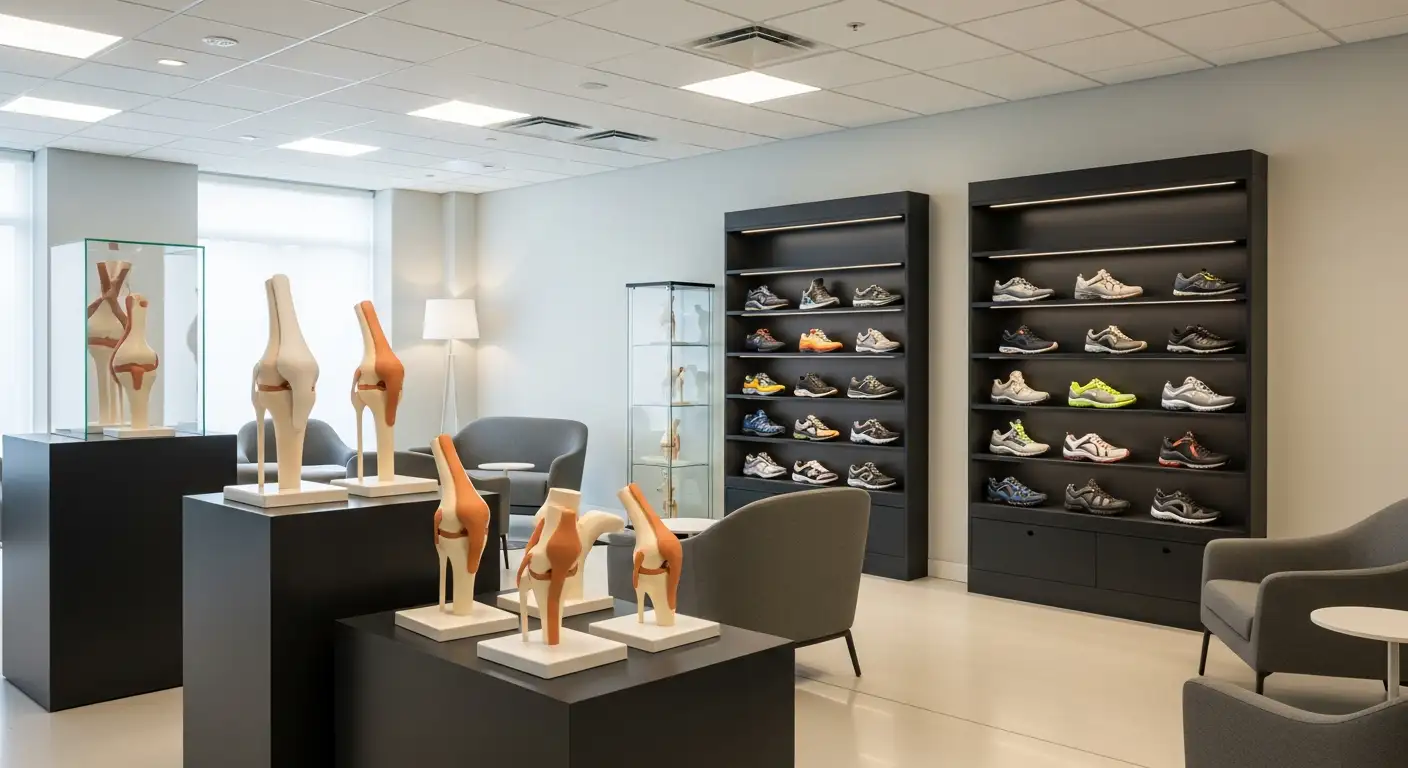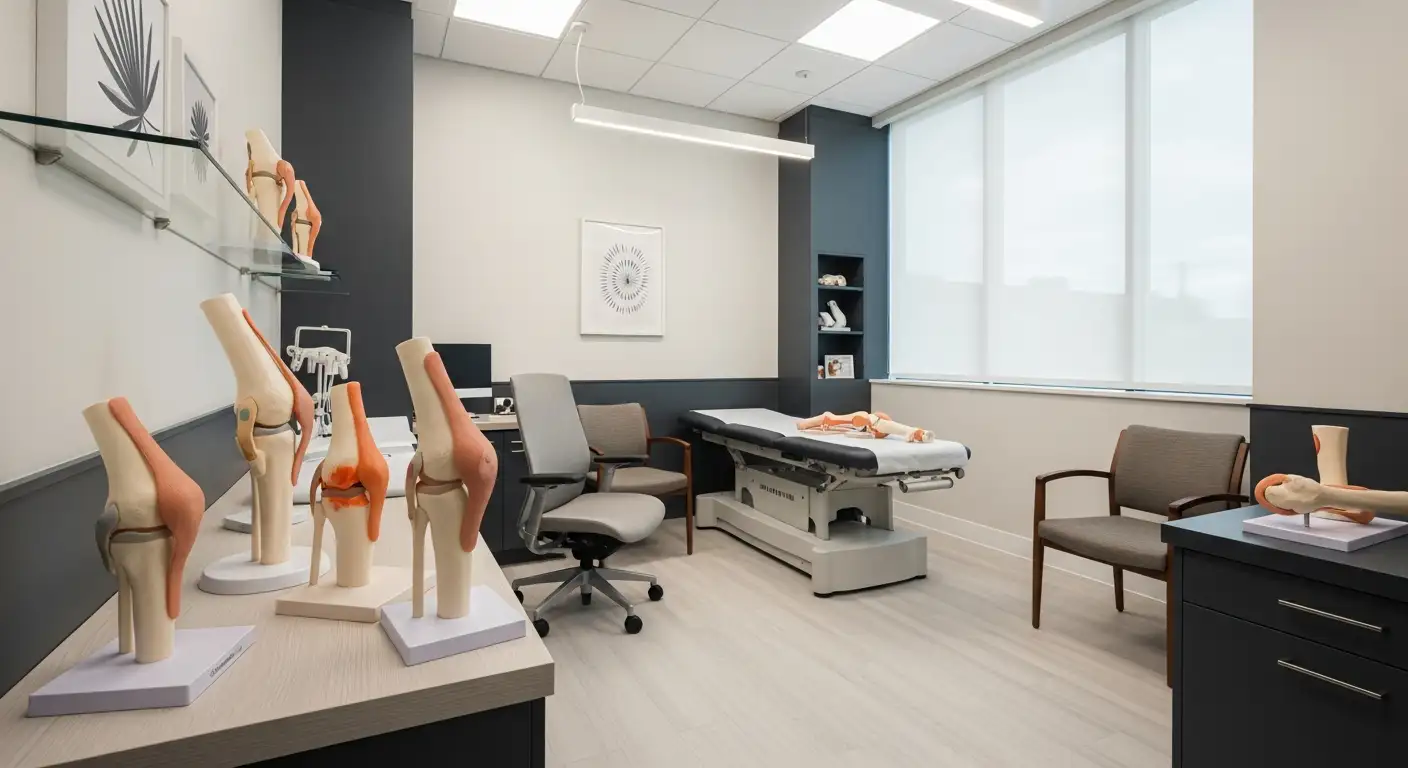Understanding Osteoarthritis and the Role of Knee Braces
Osteoarthritis (OA) of the knee is a prevalent and painful condition characterized by the deterioration of cartilage, leading to bone-on-bone contact, inflammation, and stiffness. As one of the most common forms of arthritis affecting the knee, it impairs mobility and quality of life. While there is no cure for osteoarthritis, various conservative treatments aim to manage symptoms, improve joint function, and slow disease progression. Among these, knee braces have emerged as effective supportive devices that can help alleviate pain, improve stability, and enhance activity levels.
Types of Knee Braces for Osteoarthritis and Their Functions
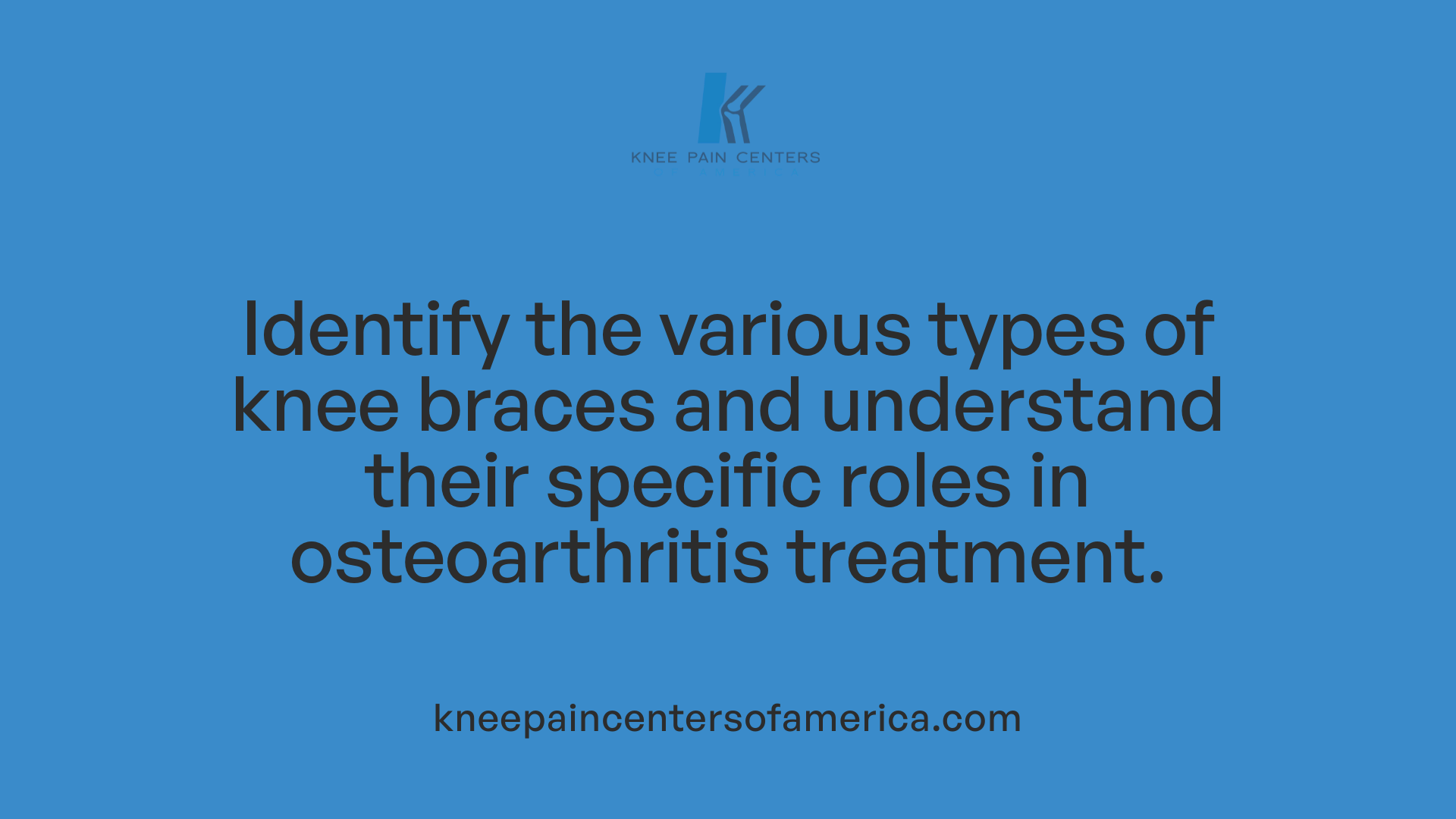
What are the different types of knee braces suitable for osteoarthritis?
Individuals with osteoarthritis have a variety of knee brace options to help manage pain, improve stability, and support mobility. Each type of brace serves a specific purpose based on the severity of symptoms and the area of the knee affected.
Unloader and offloader braces are among the most researched and recommended for moderate to severe medial (inner) knee osteoarthritis. These braces are designed to reduce pressure on the affected compartment by shifting weight to healthier parts of the knee. They typically have a rigid structure to redistribute load, easing pain and improving function.
Hinged knee braces offer additional support and stability during movement. They often include metal hinges on the sides that allow controlled motion while preventing excessive or harmful movements. These braces are suitable for daily activities, post-surgery recovery, or injury support, and sometimes feature a cut-out over the kneecap to enhance comfort.
Compression sleeves and neoprene braces are softer options that provide gentle support and warmth. They help reduce swelling, improve proprioception (body awareness), and are ideal for mild pain or stiffness during daily activities, exercise, or sports.
Custom-fit and adjustable braces are tailored to fit the individual’s knee anatomy with the help of healthcare professionals. These are particularly beneficial for moderate to severe instability or when precise load distribution is necessary. Adjustability features allow modifications to ensure comfort and effectiveness.
Choosing the right brace depends on your specific diagnosis, the severity of osteoarthritis, and your body's needs. Consulting a healthcare provider can help determine the most suitable option, often used in conjunction with physical therapy, weight management, and medication to control symptoms effectively.
How Knee Braces Alleviate Osteoarthritis Symptoms
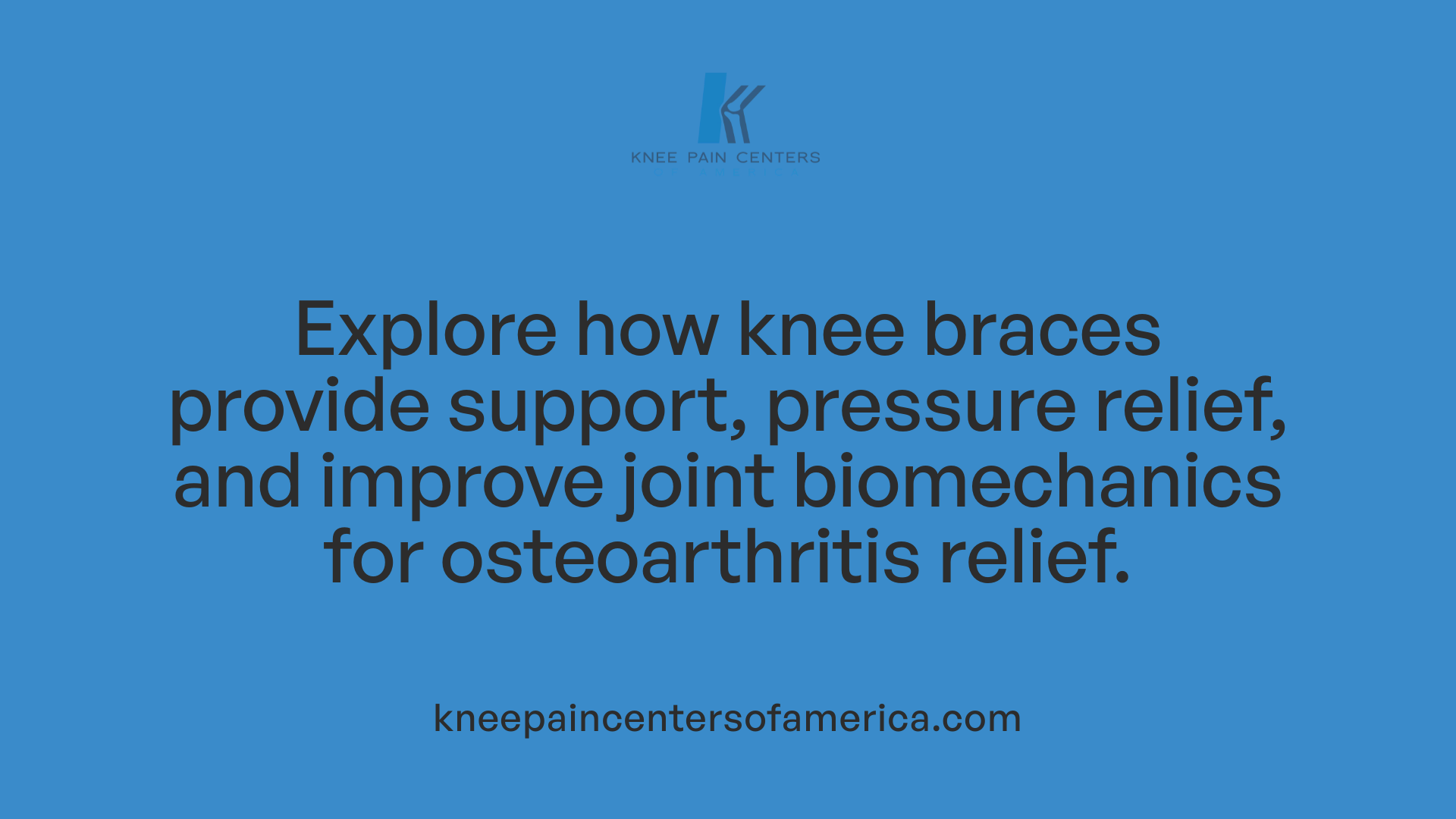
Support and stabilization benefits
Knee braces play a vital role in managing osteoarthritis by offering support that stabilizes the joint. They can help prevent unnatural movements that might worsen pain or cause additional injury. Hinged and immobilizing braces are especially useful for offering controlled movement and joint stability. This support not only eases discomfort but also encourages more confident walking and daily activity.
Pressure shifting and weight distribution
One of the main ways knee braces help osteoarthritis symptoms is by redistributing pressure across the knee joint. Many braces, especially unloader and offloader types, are designed to shift weight away from the damaged, painful areas. For example, unloader braces applied on the medial or lateral side of the knee help transfer pressure to healthier cartilage, lessening the contact between bone-on-bone surfaces. This redistribution can significantly reduce pain during movement and everyday activities.
Reducing strain on affected joints
Knee braces are instrumental in lowering the physical strain on compromised cartilage and bones. Compression sleeves and soft braces help alleviate swelling and improve proprioception or joint awareness, which can decrease the risk of further injury. Supportive braces, like the Bauerfeind GenuTrain A3 or DonJoy OA braces, specifically target reducing inflammation and pain through gentle compression and stabilization.
Improving joint biomechanics during movement
Proper alignment is essential for reducing osteoarthritis symptoms. Knee braces correct misalignments, keep the joint in optimal position, and assist in biomechanics during walking or activity. For instance, braces with a cutout or patella support guide the kneecap’s movement, relieving pain caused by improper patella tracking. This improved biomechanics not only reduces discomfort but also encourages more active lifestyles, which are crucial for joint health.
| Type of Knee Brace | Main Benefits | Suitable for | Additional Features |
|---|---|---|---|
| Unloader & Offloader | Shift pressure, reduce pain | Moderate to severe osteoarthritis | Designed to unload affected compartments |
| Compression Sleeve | Reduce swelling, support stability | Mild to moderate pain | Lightweight, breathable, easy to wear |
| Hinged Braces | Stabilize, facilitate controlled movement | Post-injury or daily use | Adjustable hinges for mobility control |
| Patellofemoral Braces | Improve kneecap alignment | Anterior knee pain | Patella tracking support |
| Custom Fit Braces | Precise support, load distribution | Moderate to severe instability | Designed with professional input |
When choosing a knee brace, individual diagnosis and body type are crucial factors. Consulting a healthcare professional ensures selecting the most suitable type and fit to maximize benefits.
Choosing the Right Knee Brace for Your Condition
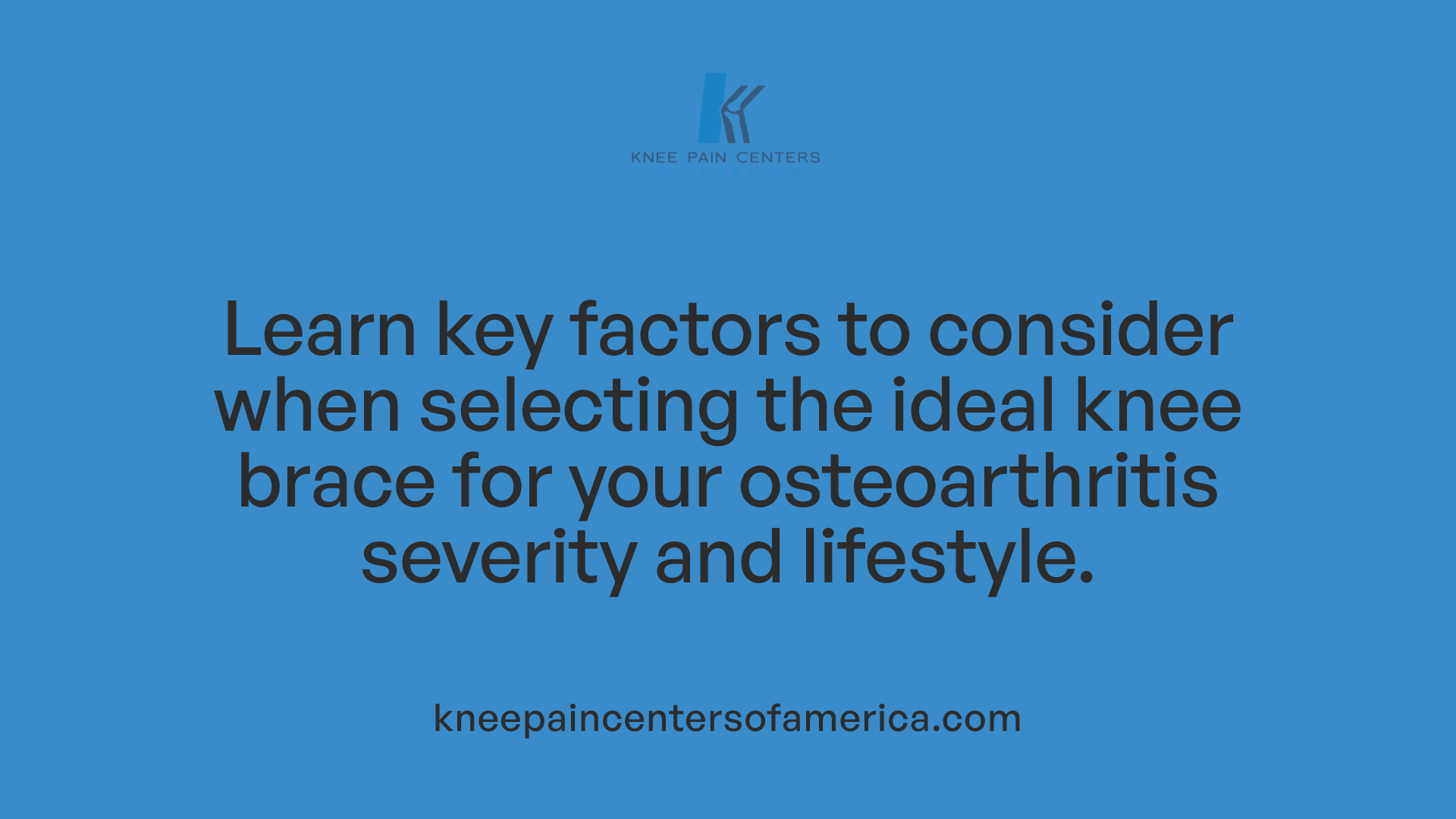
What factors should be considered when choosing a knee brace for osteoarthritis?
Selecting an appropriate knee brace for osteoarthritis depends on multiple factors to ensure comfort, effectiveness, and support. First, consider the severity and specific location of the arthritis. For example, unloader braces are highly recommended for moderate to severe medial (inner) knee osteoarthritis as they help shift the stress away from the affected part of the knee.
Next, fit and comfort are crucial. A well-fitting brace prevents skin irritation, swelling, or stiffness and enhances mobility. Consulting with a healthcare professional or orthotist can help determine the correct size and ensure the brace maintains proper support during movement.
The support level varies by brace type. Compression sleeves and soft braces are suitable for mild pain and daily activities, while hinged or customizable braces offer more stability for moderate to severe cases or post-surgery use.
Support, durability, and cost are also important considerations. Over-the-counter options such as compression sleeves or basic braces are generally more affordable but may lack the personalized fit of custom braces. Custom-fitted braces, while more expensive, often provide better load distribution and enhanced support, which can be especially beneficial for serious instability.
Also, consider adjustability features like straps or hinges that allow tailored support during different activities. The brace's material should be lightweight and breathable to promote comfort during extended wear.
Properly chosen knee support is a vital part of a comprehensive osteoarthritis treatment plan, which might include physical therapy, weight management, and medications. Always consult healthcare professionals to select a brace that best fits your individual needs, ensuring optimal support, pain relief, and mobility.
The Effectiveness of Different Knee Braces in Pain Relief
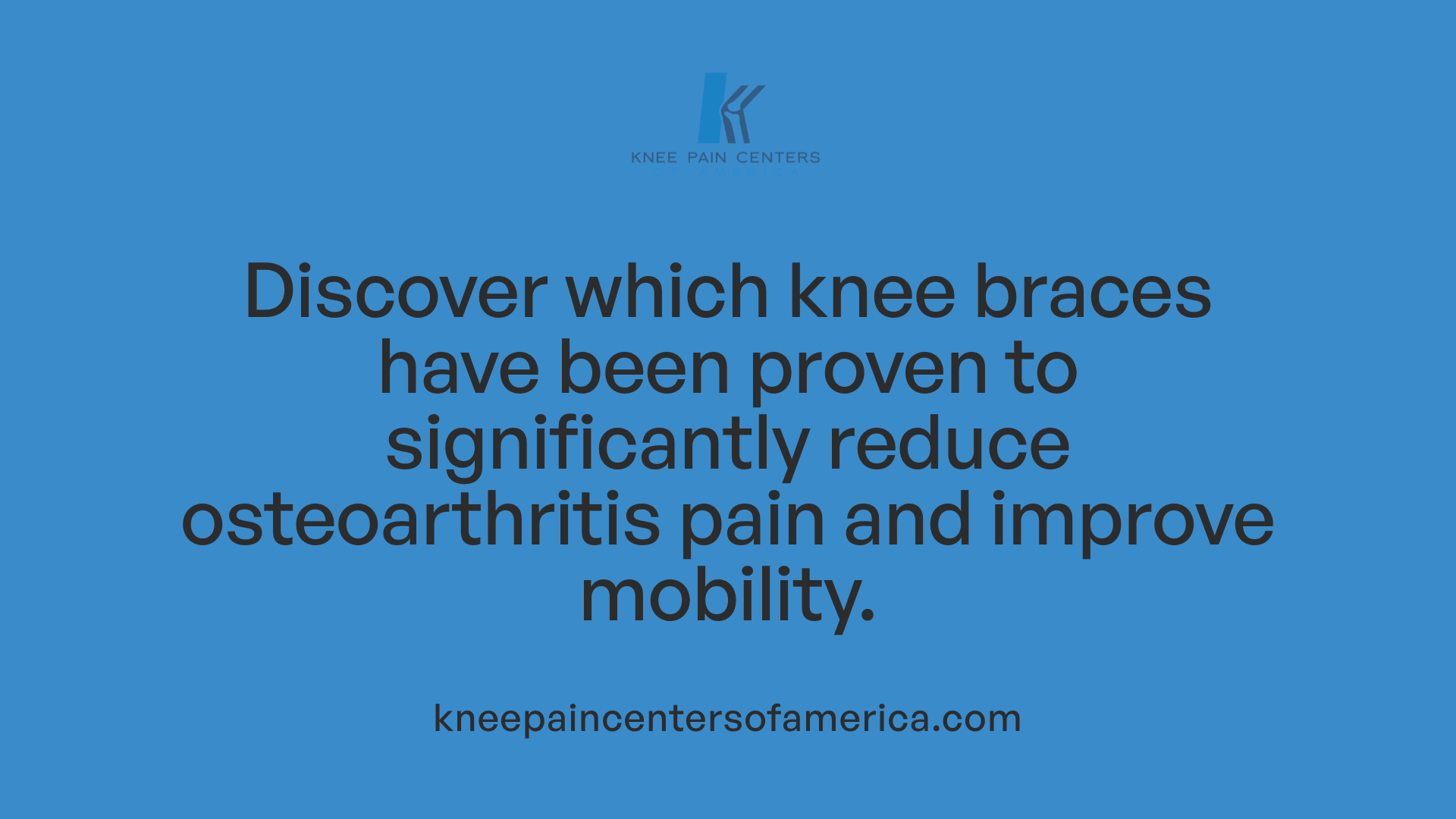
How effective are different knee braces for osteoarthritis in relieving pain?
Knee braces can play a significant role in alleviating pain caused by osteoarthritis. Different types of braces serve specific functions, from offering compression and support to redistributing joint pressure.
Research shows that semi-rigid knee braces, such as unloader and offloader models, can dramatically reduce pain. In fact, some users experience up to a 54% decrease in pain levels. These braces work by shifting the load away from the damaged part of the knee, especially in cases of medial (inner) compartment osteoarthritis, which often requires specialized unloader braces.
Besides unloader braces, compression sleeves and hinged supports also contribute to pain relief. Compression sleeves help reduce swelling and improve proprioception, while hinged braces stabilize the knee and allow controlled movement.
Systematic reviews indicate that knee braces used alongside other therapies, such as foot orthoses, might decrease pain, stiffness, and dependency on medication. They also enhance knee stability, mobility, and balance.
Comparison of brace types and outcomes
| Brace Type | Purpose | Effectiveness | Suitable For |
|---|---|---|---|
| Compression Sleeve | Swelling, proprioception | Moderate pain reduction; good for daily support | Mild osteoarthritis, daily activities |
| Hinged Knee Brace | Stability, controlled movement | Improves stability; helpful post-injury or surgery | Post-operative recovery, injury recovery |
| Unloader & Offloader | Reducing joint load in severe cases | Significant pain relief; decreases pressure on joint | Moderate to severe medial/lateral OA |
While specific outcomes depend on individual conditions, evidence supports the use of these braces in improving function and reducing pain.
Role of braces as part of a broader treatment plan
Knee braces are an important component of conservative osteoarthritis management. They complement other approaches like physical therapy, weight management, exercise, and medications.
Using braces can delay the need for surgical intervention and help maintain an active lifestyle. For optimal benefits, professional guidance is recommended to select the appropriate type and ensure proper fitting.
In summary, well-chosen knee braces, especially unloader models supported by research, can substantially reduce osteoarthritis-related pain and enhance mobility, contributing positively to the overall treatment strategy.
Top Recommended Knee Braces and Innovations for Osteoarthritis
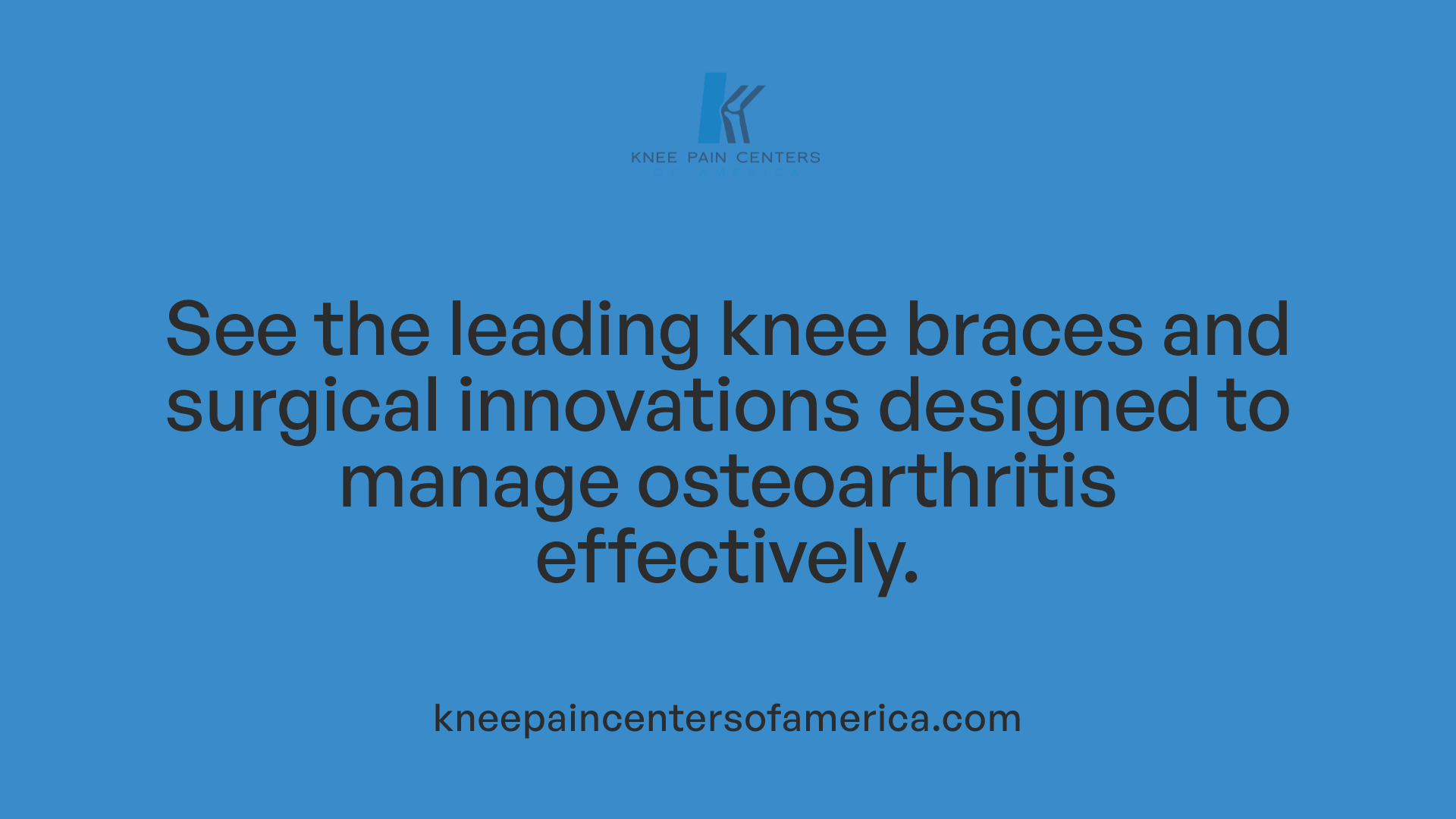
What are some recommended knee braces to manage osteoarthritis pain?
For those dealing with osteoarthritis, selecting the right knee brace can significantly alleviate pain and improve mobility. Popular options include compression sleeves, hinged braces, and unloader braces.
Compression sleeves, like the Bauerfeind GenuTrain A3, are lightweight and designed to support blood flow, reduce swelling, and provide gentle compression. They are ideal for mild osteoarthritis and daily activities. These sleeves also enhance proprioception, helping wearers move more confidently.
Hinged knee braces offer greater stability and control, making them suitable for moderate to severe cases or post-injury recovery. They facilitate safer movement and protect the joint during activity.
Unloader braces target medial (inner) knee osteoarthritis specifically. They help shift weight away from the affected compartment by redistributing pressure, which can significantly decrease pain. The Bauerfeind GenuTrain OA and Ossur Unloader One are leading models supported by extensive research.
It's important to note that the effectiveness of these braces varies based on individual diagnosis, and they should be incorporated into a comprehensive treatment strategy. Consulting healthcare professionals ensures the most suitable choice tailored to personal needs.
Emerging surgical devices and treatment options, e.g., MISHA Knee System
While knee braces provide conservative management, innovations in surgical treatment are also evolving to address osteoarthritis more effectively. One such advancement is the MISHA Knee System, a minimally invasive surgical device designed to realign joints and reduce stress on damaged areas.
These newer devices aim to delay or avoid more invasive procedures like full knee replacement by providing joint stabilization, promoting cartilage health, or assisting in joint realignment.
Despite these emerging options, non-surgical approaches like braces remain vital for many patients, offering pain relief, support, and functional improvement. Combining technology-driven surgical solutions with conservative measures offers a comprehensive path to maintaining mobility and quality of life for osteoarthritis sufferers.
Overview of top knee brace options and innovations
| Brand / Model | Type of Brace | Specific Benefits | Suitable For |
|---|---|---|---|
| Bauerfeind GenuTrain A3 | Compression sleeve | Reduces swelling, pain, improves proprioception | Mild to moderate osteoarthritis |
| Bauerfeind GenuTrain OA | Unloader knee brace | Shifts pressure, alleviates medial knee pain | Medial knee osteoarthritis |
| DonJoy OAdjuster | Adjustable offloader brace | Custom fit, reduces joint load | Severe osteoarthritis, complex cases |
| Ossur Unloader One | Unloader offloader brace | Decreases joint stress, pain relief | Severe medial osteoarthritis |
| MISHA Knee System | Surgical implant | Joint realignment, future treatment | Advanced cases considering surgery |
These models demonstrate a range of options from simple compression sleeves to specialized unloader braces and innovative surgical devices. Choosing the right support depends on individual diagnosis, lifestyle, and professional medical advice. Incorporating these tools into a broader treatment plan—including physical therapy and weight management—can significantly improve osteoarthritis symptoms and overall joint health.
Supporting Long-Term Management of Osteoarthritis
While knee braces are not a cure for osteoarthritis, they can play a crucial role in managing symptoms, delaying progression, and improving overall joint function. For severe cases, especially those involving bone-on-bone contact, specialized options like unloader braces have proven benefits supported by research. Selecting the appropriate brace involves balance—considering fit, support, and personal needs—and should always be done with professional guidance. When integrated into a broader treatment approach, which includes physical therapy, weight management, and medication, knee braces can significantly enhance quality of life and sustain mobility for arthritis sufferers.
References
- Knee Braces for Osteoarthritis - Mass General Brigham
- Braces for Knee Osteoarthritis / OA Knee Pain - DonJoy Store
- Best Knee Brace for Arthritis | Health Blog | Bauerfeind
- 8 Best Knee Braces for Arthritis - Healthline
- What to Know About Knee Braces and Osteoarthritis - WebMD
- Best Knee Braces for Osteoarthritis (OA) & Bone on Bone Pain
- Best Knee Brace for Bone on Bone Arthritis | AKPC
- Types of Knee Braces for Arthritis - Medical News Today
- Knee Braces for Osteoarthritis - Mass General Brigham
- What to Know About Knee Braces and Osteoarthritis - WebMD
